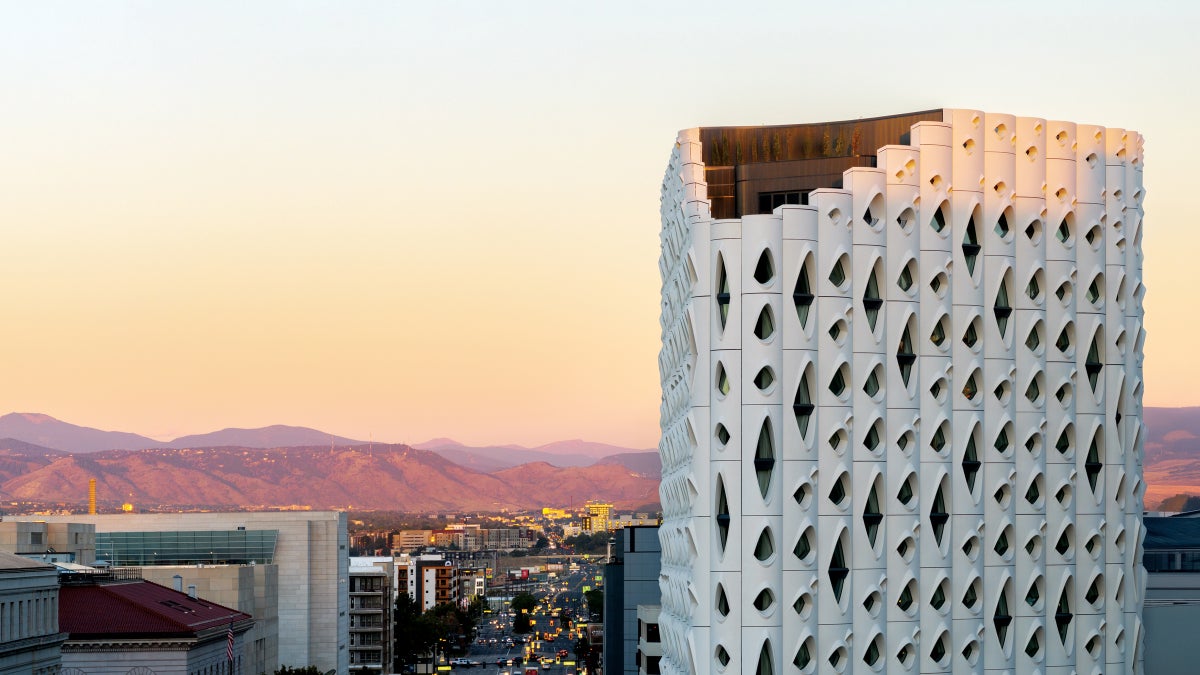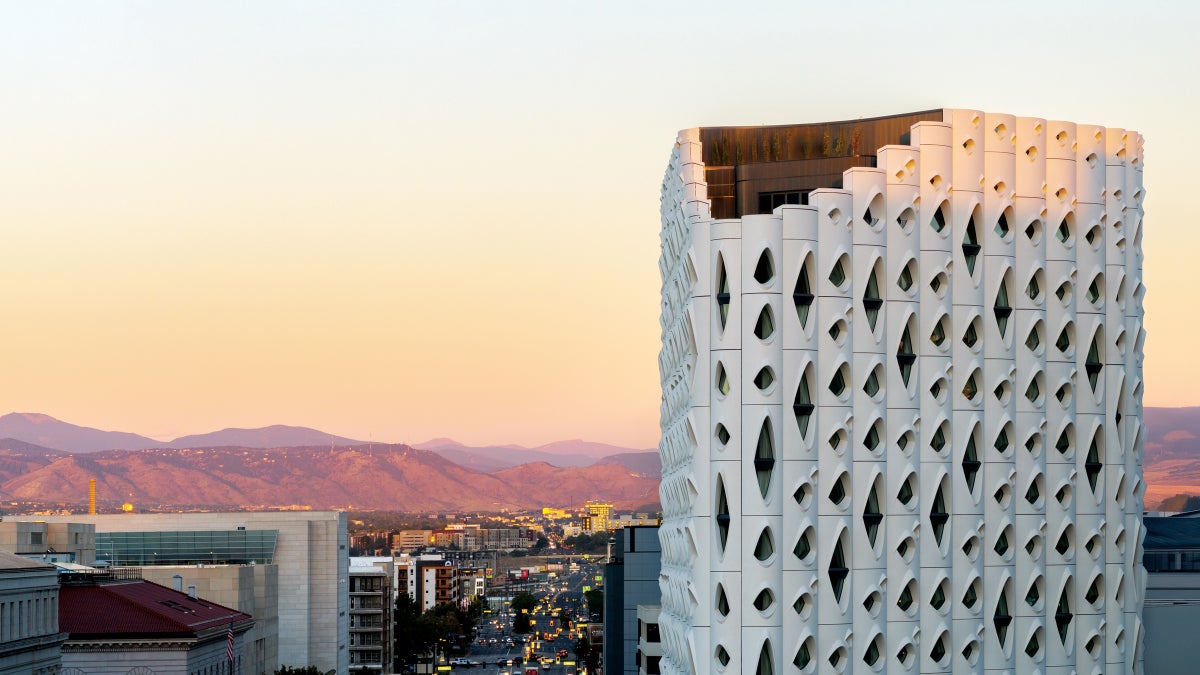
The recently opened Populus hotel cleverly channels the feel of walking through an aspen grove from its forest floor-inspired lobby all the way to its “canopy”-level rooftop bar. Located across from Civic Center Park, the 13-story building’s curvy, white-washed facade is reminiscent of the work embraced by Antoni Gaudí, the Catalan architect and early adopter of biomimicry, a design practice that imitates nature. Jeanne Gang, the founder of award-winning architecture firm Studio Gang, takes the concept to a new level with Populus.
The hotel’s moniker comes from the scientific name for the quaking aspen (Populus tremuloides), the native tree that served as muse for the project. An avid hiker, Gang explored many of Colorado’s aspen groves early on in the creative process; the hotel’s 365 windows were designed to evoke the dark, eye-shaped marks left behind on the bark as aspens shed their lower branches. Aspens also sequester huge amounts of carbon dioxide, as does Populus, which owns bragging rights as being the first carbon positive hotel in the U.S. (meaning it removes more carbon dioxide from the air than it emits.)
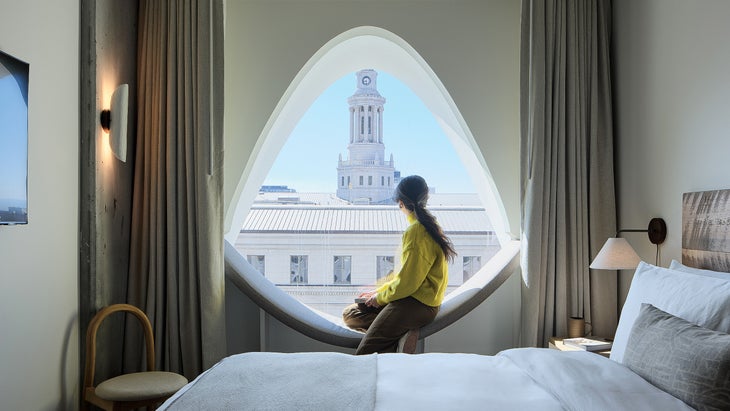
Innovative sustainability strategies include the use of low-carbon concrete, 100 percent renewable energy, and converting every scrap of food into compost that gets returned to local farms. The building’s distinctive windows have a unique hood that provides shade while efficiently deflecting rainwater from the exterior, reducing the building’s energy needs for temperature control. Rather than purchase carbon credits, the project’s Seattle-based developer, Urban Villages, partnered with the U.S. Forest service to plant more than 70,000 Engelmann spruce trees near Colorado’s La Garita Wilderness to offset their carbon footprint during construction. They will continue to negate their impact by planting one tree for every guest night at the hotel.
“Our goal is to better the environment and actively inspire a reverence for nature among everyone who walks through the doors,” said Jon Buerge, president of Urban Villages.
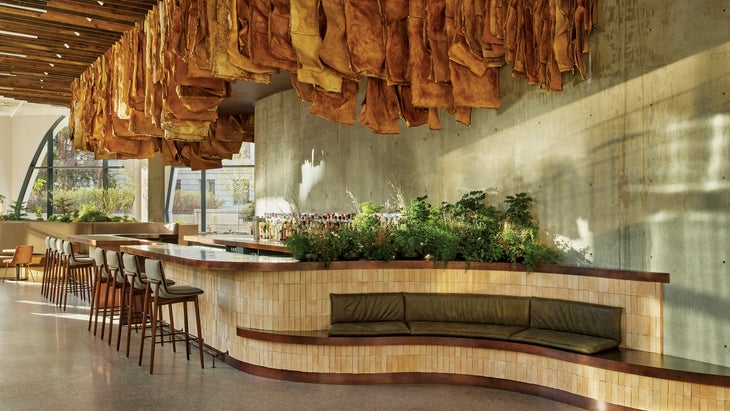
Wilderness wonders greet guests at nearly every turn, from an elevator soundtrack of bugling elk and birdsong that was recorded in Rocky Mountain National Park to headboards crafted from fallen beetle kill pine (a significant problem in Colorado’s forests). As guests enter the hotel, they’re hit with an earthy aroma that emanates from a stunning ceiling installation made from some 500 sheets of Reishi, an eco-friendly leather alternative sourced from the root of mushrooms.
Other touches are more subtle. The poured concrete floor, for example, showcases exposed aggregate with irregularity in scale and sheen similar to pebbles and rocks scattered across a forest floor. “When I take a walk in the woods I’m overtaken by a feeling of serenity. As I go deeper I start to pay attention to the details, like the patches of moss or sprouting mushrooms,” said Heather Wildman, the principal of Wildman Chalmers Design, the Pittsburgh-based firm behind the interiors. “I wanted guests to have that same feeling throughout their stay at the hotel.”
After checking in at the reception desk (a gorgeous slab of kiln-dried, locally-salvaged Rio Grande cottonwood), guests transition to guest floors, which are intentionally low-lit to signal a departure from the forest floor to the heart of the aspen tree. Each of the 265 guest rooms and suites are done up in warm earth tones and feature biodegradable carpets, drinking glasses made from recycled wine bottles, and those signature windows perfectly frame the State Capital, City Hall, and the distant Rocky Mountains.
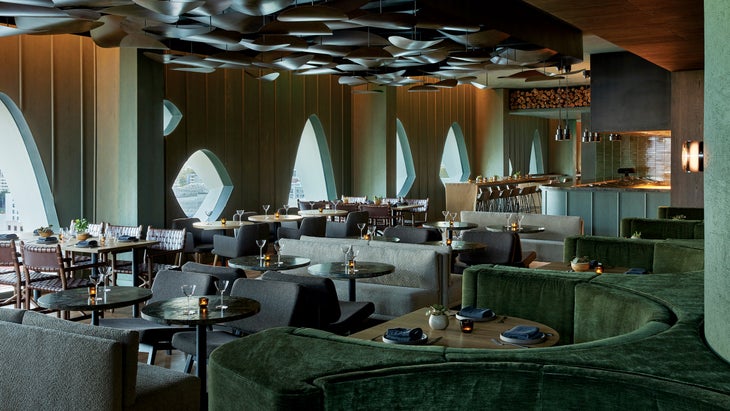
The best views, however, await at Stellar Jay, the hotel’s rooftop restaurant and bar. Intended to feel like a lush tree canopy, the dining room is a mix of forest green velvet banquettes, wooden high-top counters and low, stone tables with veining that looks like a web of lichen. Some walls are covered in cork, while others look like works of art, composed of apple and Siberian elm tree slices scorched using yakisugi, the Japanese wood preservation technique. In the dining room, a light installation of layered steel discs refracts rays as if guests are peeking through leaves. Above the double-sided bar, a custom installation of tiny white lights looks like a starry night sky in the evenings. The bar spills out to a large terrace with sweeping city view and is landscaped with perennial trees and flowers, intended to be an urban oasis for the public as well as pollinators. From $499; populusdenver.com
This piece first appeared in the summer 2025 print issue of Outside Magazine. Subscribe for captivating storytelling, stunning photography, and deeply reported features on the biggest issues facing the outdoor world.
The post Denver’s Newest Hotel is a Towering Treehouse in the Heart of the City appeared first on Outside Online.











